Glorious Sunlight
Wonderful, energizing sunlight essentially powers most life forms on earth.
It provides for reproduction, energy and longevity for not just us humans, but plant life on both land and in water, as well as animals ranging from small and large to marine and land-based.
Sunlight as medicine
When it comes to the human race, there is no better medicine than that of sun's rays!
Not only is it free and abundant, but proven in its health rejuvenation capabilities. There is so much to be gained if we, as a human race, embrace the solar power and learn that it can help us to...
- Cure Depression
- Beat Cancer
- Prevent Heart Disease
- Build Stronger Bones
- Live a Longer, Healthier Life
Poisoning your body with toxic sunscreen chemicals while blocking out the nourishing sun's UVB rays that generates vitamin D in the skin "is nothing short of health lunacy" according to Mike Adams, a Consumer Health Advocate.
Vitamin D is claimed to help us to reduce all of the above health issues and cancer specifically, in reducing the risk by about 50%.
To quote further, a Certified Neuromuscular Therapist, Leif Grunseth, said "It has been clearly established that the only way for your body to synthesize vitamin D is in your skin once it's exposed to UV rays from the sun. Hence, the current guidelines to avoid sun exposure, and the fervent pushing of sunscreen, are perhaps some of the most misguided and dangerous health recommendations out there."
Dr. BG, a Pharmacologist, furthers this sentiment in saying...
"Vitamin D is a hormone... powerful, potent, and paleo-to-the-core. Since pre-paleolithic times, Vitamin D has been produced in our skin from the UVB radiation of sunlight."
Beyond its health giving capabilities, the sun has the ability to evoke pure joy in many people.
The following quotes, taken from a wonderful web site on sun matters, Sunlightenment, describe some of the delights of the energy we feel from the sun.
Jessi Lane Adams
"I'm not a doctor and I don't know the technical terminology, but I do know that sunshine activates our happiness glands."
Astrid Alauda, author
"The sun is nature's Prozac."
Star Riches
"They may as well have called the sun a ball of flaming joy."
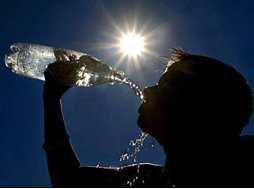 Sunshine and water are precious to life
Sunshine and water are precious to lifeEverything, from an individual person to the Earth as a whole, emits energy. As the Earth absorbs solar energy, it warms up. In order to keep the Earth at a temperature that is hospitable to all life forms on Earth that exist today, it needs to emit some of this warmth, or energy, back out into space.
This outgoing energy from Earth has two components...
- thermal radiation emitted by the Earth's surface and atmosphere, as felt particularly in heat waves, and
- solar radiation reflected back to deep space by the oceans, lands, aerosols and clouds
The balance between these 2 and the energy acquired from the Sun, is what scientists refer to as the Earth's "radiation budget". This is what determines the Earth's temperature and climate.
In the diagram below, taken from Wikipedia, the net energy transfer is illustrated, showing that the total energy entering is equal to the total energy leaving, which is what is expected when a system is in balance. This balance is affected by both natural and human-induced activities, including the contentious greenhouse gases and such.
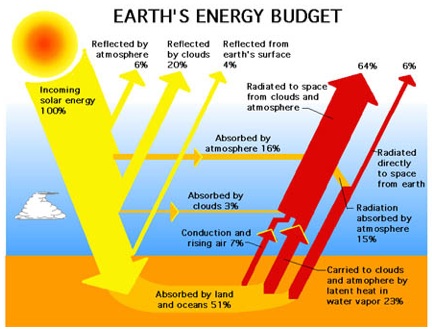 Wikipedia: the net energy transfer
Wikipedia: the net energy transferWithin this incoming solar energy are three forms of light:
- infrared (heat)
- visible light
- ultraviolet (UV) light
Within the ultraviolet light, there are three types of light rays...
- UVA (320-400 nanometers, or one-billionth of an inch): Causes premature skin aging, wrinkling and potentially skin cancer. Penetrates skin more deeply than UVB rays. Can impact skin during any hour of daylight. Can penetrate clouds and untreated glass.
- UVB (290-320 nm): Causes sunburn and contributes to premature skin aging and potentially to skin cancer. Causes most impact between 10am and 4pm. Can penetrate clouds, but not glass.
- UVC (200-290 nm): Deadly to humans. Fortunately, UVC is absorbed by atmospheric gases, before it reaches the earth's surface.
Prolonged or excessive exposure to UVB rays can damage and kill the skin's cells. In turn this will release chemicals to activate the body's pain receptors. This then results in increased blood flow to the damaged areas in order to remove the dead cells, which is what we know as sunburn. Because of these processes involved, by the time we realize we have sun burnt skin, it can be very painful!
Melanin and sunlight
The energy from the UV light also stimulates the production of a pigment known as melanin, which causes the skin to darken, or tan.
Melanin actually absorbs the UV radiation in sunlight, doing its best to protect our skin cells from further damage. However, melanin is only produced gradually, which is why those who wish to create a sun tan are recommended to build up their levels of this protective pigment in their skin cells slowly. Preferably over the course of several days.
However, many people expect their skin to acquire a tan in just one day in the sun and acquire one of those dangerous sun burns instead.
Darker-skinned people possess naturally higher levels of melanin than fairer skinned people, so are less likely to burn or even suffer from skin cancer.
In contrast, albinos miss a critical enzyme required for melanin production and thus don't possess any melanin in their skin, their hair, or even their irises. As a result they are required to avoid the sun as much as they possibly can, acquiring sun protection through use of sun protective clothing, sunscreen (hopefully a healthy organic one) and physical sun shade.
 Animals with contrasting Melanin content in their stripes
Animals with contrasting Melanin content in their stripesSunlight, the UV Index and the Ozone
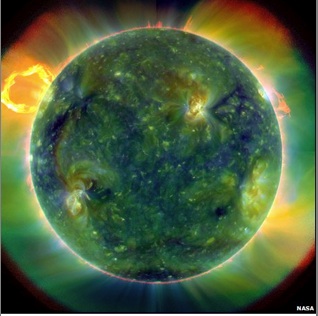 NASA picture of the sun
NASA picture of the sunThe UV index is a standard measure of the amount of UV radiation striking the Earth's surface, and the most accurate measure of your sunlight exposure risk.
In the northern hemisphere, the UV index starts to increase in March and April, peaking every year in June. The southern hemisphere UV index is seasonally in reverse of course - peaking around December.
The ozone layer in the Earth's upper stratosphere absorbs most of the sun's UV radiation, but as long as there is ongoing damage to that protective layer, UV-related health risks will continue to increase. There has been some encouraging noted closing of the holes in the ozone though but it seems to fluctuate.
NASA solar experts report that 2009 was the strongest and most active sun activity cycle in nearly 50 years, a state they expect to persist for the next 7-10 years.
As a result, people will need more UV sunlight protection than ever before.
Avoiding the sunlight
Many dermatologists will tell you to hide away from the sunlight as much as possible and modern living, especially city living, would have us believe we are better off living inside only - in our offices, homes, shopping and entertainment centers and of course, our cars.
Not so very long ago, we were all naked, or semi-naked, in a climate where we could be so.
The sun can affect us in many different ways but as long as you understand how powerfully sunlight works for us, including all the advantages and disadvantages, you shouldn't have any reason to minimize your activities in the sunlight outdoors.
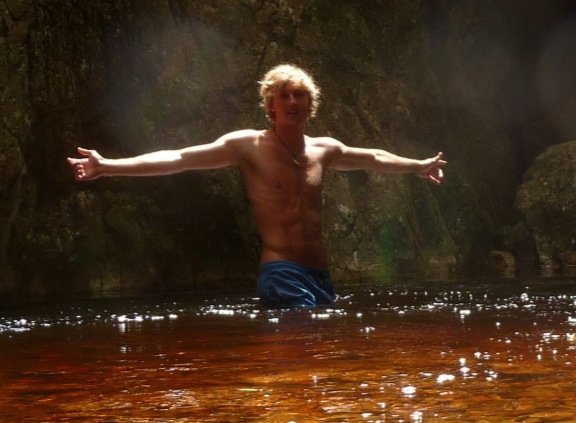
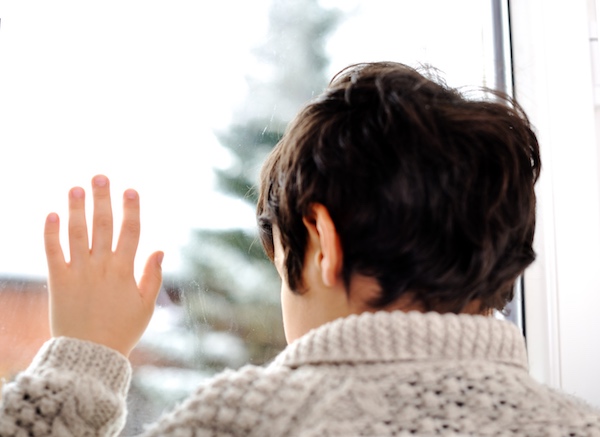




New! Comments
Have your say... please leave me a comment in the box below.